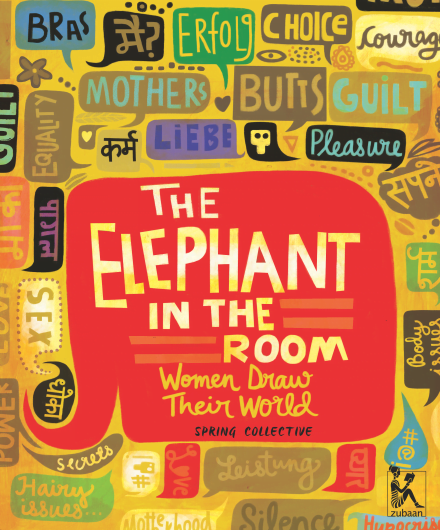What is the socio-cultural identity of a woman in the modern world? How far have we come from the caveman narrative?
The Elephant in The Room: Women Draw their world is an anthology series co-published by Zubaan, which is an independent feminist publishing house in New Delhi and Spring Collective, a magazine founded by women artists in Hamburg, Germany. Sixteen artists from India and Germany have drawn their experience of coping with gendered expectations in the 21st century and deconstructing the ideologue behind a modern woman.
It explores the singular identity women are assigned in a typical patriarchal setup and displays the banality of it. It explores motherhood as a choice, usage of the term ‘bitch’ subversively, reclaiming one’s own body, the difference in the generational experience of gendered expectations and dealing with singular representation of beauty standards.
Reese Witherspoon recently emphasized the importance of stories by women and the legitimization of their experience in the context of her HBO mini series Big Little Lies. The Elephant in the Room addresses the elephant in the room, that of the emergence of women’s stories and stories by women, and stories that are not susceptible to the male gaze. As put by Zubaan on their website the book makes conversation about the “awkward and difficult”.
In an illustration by Archana Sreenivasan in the book by the name Otherly Urges, motherhood is explored as a compulsory narrative that is thrust upon women, and how the non-conformity to that narrative is considered an aberration. She questions the compulsion of such an arbitrary rule, where women compulsorily have to derive meaning from only one particular source even when she is otherwise content. Caveman narrative is limiting and should not be considered sacred.
You could choose not to be a mother and reclaim the narrative. You could choose to be a mother and reclaim the narrative.
But in Bum Power illustrated by Larissa Bertonasco the illustrator explores how motherhood helped her in reclaiming her body as she struggled with body image because it did not conform to singular and limiting beauty standards. The Elephant in the room explores different perspective of women, and dismantles the need to serve the male experience of the world.
You could choose not to be a mother and reclaim the narrative. You could choose to be a mother and reclaim the narrative.
This is only an example out of the book of how women are navigating what it means to be a woman in the modern world. The personal is political, and these women negotiate with patriarchal spaces in both the most and subtle and overt forms as they de-stigmatize the conversation around women’s experiences.
The artists hilariously approach the misconceptions around women’s bodies and what it means to be female, and the illustrations also include sensitive narration of generational experience with gendered expectations, with artists talking about their mothers and grandmothers and their perception of gender roles which they were initiated into.
A person’s experience, irrespective of whether it fits the mould of a particular ideologue should be given legitimacy as any other experience, because it exists. The patriarchal experience is inadequate and comes at the cost of not accommodating several experiences while giving precedence to only a few, or rather just one – that of a cis hetero-man.
The book is diverse in presentation of women’s experiences across different age groups, setting and concerns and gives legitimacy to each and every one of them. It transcends traditional storytelling with its celebration of the female gaze. All the artists brilliantly explore and de-stigmatize the conversation around women’s bodies, their desires and perception of the world.
All the artists brilliantly explore and de-stigmatize the conversation around women’s bodies, their desires and perception of the world.
In a book released prior to this, Drawing the line (2015), also published by Zubaan, women artists and writers came together and in a subversive attempt to take the narrative in their own hands and did something similar. The book was released in response to the Nirbhaya incident which instigated nationwide protests due Government’s inadequacy to deal with violence against women, and perpetuation of rape culture and victim blaming by some of the politicians.
The book aimed to normalize the female experience and bring it to the mainstream discourse to battle oppressive structures that perpetuate the victim blaming discourse and present women as objects without agency, and included stories of women where they questioned the normalization of the agency people exercise over women’s bodies and control the articulation of her experience.
Also read: Book Review: ‘Drawing The Line’ Zubaan’s Swanky New Graphic Novel
The Elephant in the Room is the continuation of the same attempt of subverting and establishing the female experience as legitimate. Written with the support of Goethe Institute, Max Mueller Bhavan and a foreword by Manjula Padmanabhan it continues its “battle for change” as Drawing The Line and making space for women’s experiences in the mainstream narrative.
What does it mean to be a woman?
As the book claims, answering that would mean navigating the awkward and difficult and asking questions and approaching those with answers akin to revolutionary.
You can buy the book here.
About the author(s)
Holden Caulfield thinks you are a phony.




